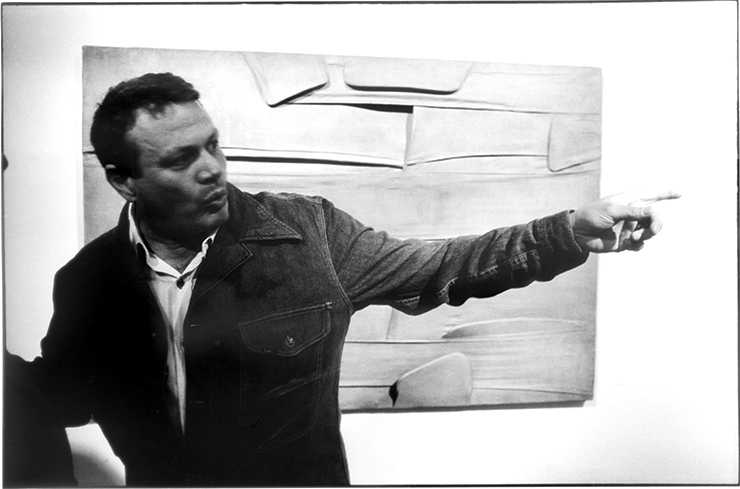
One of the most important trends in the international art world over the last decade has been the reconsideration of influential contemporary artists of the past. The recent rediscovery of experimental postwar movements such as Gutai, Zero and Dansaekhwa helped usher in a new fascination for process-oriented painting—playfully dubbed Zombie Abstraction—by a younger group of artists.
As international survey exhibitions and museum retrospectives create higher visibility and rising auction prices stir renewed interest in these historical movements, works by forgotten artists come out of storage and off the walls of collectors to impact the art world once again. It happened for the avant-garde art of Japanese painter Kazuo Shiraga, German sculptor Heinz Mack and Korean conceptualist Lee Ufan, and now it’s occurring for the experimental work of the Italian-American artist Salvatore Scarpitta, who is the subject of a show at New York’s Luxembourg & Dayan gallery in October.
Born in New York in 1919 to an Italian father and Polish-Russian mother, Scarpitta grew up in Los Angeles before moving to Italy at age 17 to study art in 1936. Caught in his father’s homeland when World War II broke out, Scarpitta began his career as an artist informed by Cubism and Futurism as well as the new wave of experimentation that was changing the face of art around the world. After the devastation of war, emerging artists understood that they had to do things differently—that changing times needed a new aesthetic approach. Scarpitta quickly moved from making figurative abstractions to Abstract Expressionist-style paintings and then to monochromatic canvases, which possessed a physical, more sculptural form.

After achieving a level of success in Italy, Scarpitta was discovered by New York gallerist Leo Castelli and persuaded to resettle to the city of his birth in 1958. In the hub of what was becoming the world’s new cultural capital, the European-minded artist was a small fish in a big sea, but with Castelli’s prestigious backing he made the right connections and began to play a key role in the developing minimal and pop art scenes. He soon became influential for his monochromatic canvases, operative racing cars and sled-like assemblages.The works in this succinct survey cover the years just prior to his relocation to New York and up until the creation of his first vehicle. Mixing loans from major institutions—including the Museum of Modern Art—and private collections with a small selection of available works, the exhibition features some 18 major paintings made between 1956 and 1964.
“In order to understand an artist who hasn’t been seen much over the past 20 years one needs to analyze the work and reveal the most important years,” gallerist Daniella Luxembourg says. “We’re trying to show his development before coming to America and his footsteps once here.” Among the show’s highlights are an expressive black, white and red painting from 1956 that has a metal structure under the canvas that gives it a relief form, as well as several monochromatic “bandage” paintings—including at least one from the 1959 Castelli exhibition—that were made with strips of overlapping raw canvas (sometimes stained with wine, coffee and other organic pigments) that were pulled and wrapped around traditional stretcher bars.

Other standout pieces include a monochromatic X-frame painting of resin-coated canvas on wood, which anticipates the primary structures of Donald Judd and Richard Serra, and mixed-media paintings that incorporate parts of racing cars (safety belts, exhaust pipes and other fragments) that had crashed on the track. Using elements that expressed a protection of the body, Scarpitta created an oeuvre that cathartically dealt with the trauma of war, which he had experienced, while also forging a radical new path for art—a pursuit that was shared by his Italian contemporaries Piero Manzoni and Lucio Fontana.
“Over the past eight years we’ve shown a number of artists who are underrepresented in American art critical discourse, including the French artists César and Martial Raysse and the Italians Domenico Gnoli and Alberto Burri,” Luxembourg says. “These artists are quite monumental and—like Scarpitta—their work is important.”
And while Scarpitta’s claims of Manzoni seeing his monochrome paintings before making his own and Fontana’s slashed canvases being inspired by the voids and cuts in his bandaged pieces seem farfetched, his influence on the minimalists and a younger generation of artists—including the Swiss sculptor Not Vital, who was his assistant in New York, and the American painter and filmmaker Julian Schnabel—is significant. The fact that Schnabel would name his daughters, Lola and Stella, after Scarpitta’s girls and his son Vito after the elder artist’s beloved dog should not be taken lightly.
Courtesy of Luxembourg & Dayan.



